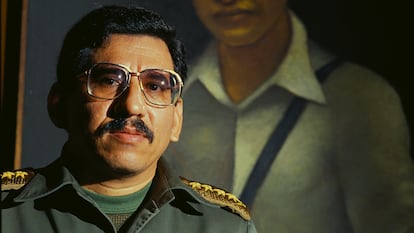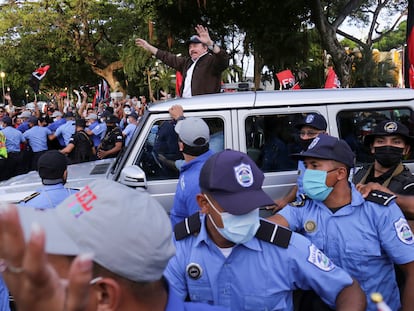Humberto Ortega, former Sandinista military strategist persecuted by the Ortega-Murillo regime, dies
The former guerrilla who became head of the Sandinista Popular Army was a feared and respected figure in Nicaragua in the 1980s. Fallen into disgrace and at odds with Vice President Rosario Murillo, he died at the age of 77 from heart complications while under house arrest by order of the presidential couple


Humberto Ortega Saavedra participated in only two major guerrilla operations in his lifetime, and both went very wrong. The first was in 1967, when a Sandinista commando unit attempted to attack the convoy of dictator Anastasio Somoza Debayle in Managua. Ortega Saavedra was arrested. The second was in 1969 in Alajuela, Costa Rica, when he devised and led a plot to try to free Carlos Fonseca Amador, a hagiographic figure of Sandinismo, from prison. Again, everything failed and not only was he arrested, he was seriously wounded by two .38 and .45 caliber bullets: one went through his chest, grazing his heart, and the other, the larger round, hit his right shoulder. It paralyzed him and he began to bleed to death. He was saved at the San Juan de Dios Hospital in San José, but he lost the use of his hands and fingers. The aftereffects proved fatal for his life as a guerrilla. He was left unfit for combat, something that was decisive for his political and military career: he became an insurrectional and warlike “strategist” that led him to become the head of the Sandinista Popular Army (SPA), after the Somoza dynasty was overthrown in 1979. He became an unavoidable and feared Sandinista figure in the following decade, and the first military chief in democracy who was key to the professionalization of the armed forces in the 1990s.
Ortega, a man of many credentials — “more shadows than lights,” say his detractors — died in the early hours of September 30 in Managua at the age of 77 while being held captive by his older brother and sister-in-law, President Daniel Ortega and Rosario Murillo. The day before his death, the Nicaraguan army issued a statement in which they reported that the retired general “experienced a sudden deterioration in his condition with cardiogenic shock.”
Ortega Saavedra’s house was surrounded by a police contingent hours after he gave an interview to journalist Fabián Medina, published in Infobae, in which he issued some criticisms that embittered the presidential couple. He said that his older brother, as leader of the authoritarian regime, has no successors, a suggestion that, like a precise arrow, hit the bull’s-eye of the family succession plan that is being pushed, above all, by his sister-in-law.
“Without Daniel there is no one, because, with everything, Daniel is the only leader, historically, who still retains the credits of that struggle [the Nicaraguan Revolution]. Without Daniel, I see it as being very difficult that there could be two or three that would come together. Much less one in particular, and more difficult still within the family. Sons who have not had the accumulated experience of a political struggle,” Ortega Saavedra said, referring to his nephew Laureano Ortega Murillo, who the presidential couple is promoting as a successor to the dynasty. Although “co-president” Murillo occupies the first line of constitutional succession, she has worked hard to shape her son Laureano, the current presidential advisor for investments and de facto foreign minister in charge of the relations of his parents’ regime, primarily with Russia and China.
Three weeks after his captivity began, Ortega Saavedra was rushed by the police to the Military Hospital with symptoms of having suffered a heart attack. On May 28, 2024, on national television, Ortega called his brother a “traitor.” Ortega Saavedra is not the first historic Sandinista leader to die in the captivity of the presidential couple, that is, at the hands of the state. Before him was Commander Hugo Torres Jiménez, a retired general, who collapsed in the El Chipote prison due to lack of adequate medical attention for a 73-year-old man with chronic illnesses. Torres Jiménez was transferred to a hospital, but it was too late for him to recover.
A complicated relationship with his sister-in-law
Sources close to the Ortega Saavedra family told EL PAÍS that Murillo and her brother-in-law have always had a troubled relationship, even before the Sandinista revolution triumphed in 1979. The then-first lady during the revolutionary period did not get along with her brother-in-law’s wife, a Costa Rican named Ligia Trejos, who was more dedicated to her children and had less of a public profile than Murillo.
Although the animosity was mutual, sources close to the Ortega Saavedra family recall that Murillo disdained Trejos and Humberto for their “opulent” lifestyle. “Rosario spoke contemptuously to Humberto’s children; she criticized them even for the clothes they wore,” says the source close to the presidential family. “She used these things to question Humberto politically and weaken the relationship he had with Daniel, because the brothers did have a political connection.”
Although he is the younger brother, the former head of the military always had a certain influence on the president. Despite their differences, Daniel Ortega used to take into account the military, political or diplomatic considerations of his younger brother. “As a military man, Humberto is very pragmatic and has always seen Rosario as crazy, impulsive, violent and aggressive. But it is not only because of her emotional position; Humberto is a realist. He knows the internal antipathies that her leadership has always generated,” the source said.
Murillo has always seen her brother-in-law as a competitor to her husband’s power and, consequently, her own. Dora María Téllez, “Commander Two,” a legendary former Sandinista guerrilla and political exile, told EL PAÍS that the relationship between the “co-president” and her brother-in-law was never good, but that it became even more strained as she gained power. “However, I don’t think at the end of the day it has that much to do with personal animosity, but rather it is a matter of political competition,” she said. “Ortega and Murillo see in Humberto a competitor, someone annoying, who does not submit to their control, who is not subject to them,” said Téllez. “He can say anything, as he has done. So this siege against Humberto — the same siege as against thousands of Nicaraguans — is to silence him. Humberto is a voice outside the country that has gotten out of hand.”
A “brilliant strategist”
In a conversation with former guerrilla Mónica Baltodano, collected in Memorias de Lucha Sandinista (Memories of Sandinista Struggle), Téllez asserts that Ortega Saavedra was “brilliant in strategic analysis, but he has never had balance in his considerations.” “He is very extremist and that is what always deteriorated his capacity for analysis. He went from railing against the bourgeoisie to becoming one of them. It is a totally contradictory thing.”
Humberto Ortega Saavedra was born in 1947 and in his youth, following in the footsteps of his brother Daniel, he joined the anti-Somoza struggle clandestinely. The brothers were not founders of the Sandinista National Liberation Front (FSLN), but years later they would become two of the main figures of the insurrection and the revolution. After unsuccessfully attacking Somoza’s convoy and leaving prison, the young Ortega Saavedra went to Cuba for military training, where he underwent several operations that partially restored the mobility in his hands. On the island he became very close to Fidel Castro. Former Sandinista guerrillas agree that he was the “pet” of the Cuban dictator. During this period, Ortega Saavedra fully developed his military facet.
In 1977, after the operations known as “Victorious October” against National Guard barracks, the Sandinista Front was divided into three factions: the Proletarians, the Prolonged Popular War (GPP) and the so-called Terceristas. The Terceristas faction was led by the Ortega Saavedra brothers. At this point in history, the sources consulted by EL PAÍS agree that Humberto was key in formulating a strategy of insurrection in the cities, contrary to the GPP faction, which preferred to fight against Somoza in the mountains.
The Terceristas’ strategy was very successful, but above all, they gained international prominence due to actions such as the 1978 assault on the National Palace that weakened the Somoza regime. “Humberto was perceived as a skilled, shrewd man, with enormous influence among the Terceristas. Humberto also had the vision of opening up politically, of broad alliances with all anti-Somoza sectors, including non-pro-socialist formations. That was a success. That opening also allowed them to approach anti-Somoza governments such as those of Panama, Venezuela, and Costa Rica. That broad policy allowed the formation of the Group of 12,” a former guerrilla who worked with Ortega Saavedra in the 1980s told EL PAÍS.
The former guerrilla, who requests anonymity for fear of reprisals, says that when the Sandinista factions united and overthrew the Somoza dictatorship in 1979, many of the Sandinista leaders were afraid of Humberto. That is why they decided that Daniel Ortega would head the National Reconstruction Board on behalf of the Sandinista National Directorate. In 1984, Humberto’s older brother was elected president of Nicaragua, while he remained as head of the Sandinista Popular Army. At that time, the brothers became the two most powerful men in Nicaragua.
The war between the Sandinistas and the Contras, the anti-revolutionary guerrilla group financed by Washington, soon broke out. These were bloody years for Nicaragua, with serious mutual violations of human rights between the two sides. It was more than war, it was a fratricidal conflict. At that time, Ortega Saavedra was the main military strategist along with General Joaquín Cuadra, second in command of the SPA.
The main wound that Nicaraguans never stopped holding Ortega Saavedra responsible for was the imposition of the Patriotic Military Service (SMP), better known as the “mandatory military service” for all men between the ages of 18 and 40. Thousands of young people were murdered, at the same time that the Sandinista Revolution committed atrocities against civilians and women while the leadership lived an opulent life, far removed from the austerity they demanded from the “people.”
In an interview with the newspaper La Prensa, Ortega Saavedra justified the SMP as a measure when voluntary military service was “insufficient to repel the United States’ war of aggression.”
Retirement and withdrawal from public life
In 1990, when the Sandinista revolution lost power at the polls to former president Violeta Barrios de Chamorro, Humberto Ortega Saavedra kept his position as head of the army. Antonio Lacayo, minister in the presidency of Barrios de Chamorro, advised her to keep the military chief in order to carry out a political transition, which ended up being overly hasty.
Military sources consulted for this article also agreed that Ortega Saavedra was a general “obsessed with the professionalization” of the army. As such, he was key in reducing the number of soldiers, removing the Sandinista surname from the Armed Forces and turning it into a body attached to the Political Constitution. “He was an important interlocutor during the transition,” says a military source.
In 1994, Barrios de Chamorro retired Ortega Saavedra, who devoted himself to writing memoirs and political assessments, while developing a facet as a businessman that he always disavowed. The origin of his fortune has always been questioned and many point out that he amassed it with the illegal sale of weapons in the 1980s, or in the Piñata of the 1990s, the distribution of public assets that the Sandinistas carried out when they lost power in 1990.
Ortega Saavedra, apart from his exquisite tastes, was a man who considered himself “an intellectual.” He lived away from public life from 1994 until his death, splitting his time between Nicaragua and Costa Rica, except when he gave interviews. He expressed his political point of view in a somewhat convoluted way, although after his brother returned to power, he became more critical of the authoritarian drift of the Sandinista leader and his wife. In 2021, in an interview with Andrés Oppenheimer on CNN, the retired general defended political prisoners and said that they were not “terrorists,” as his brother’s government claimed.
Sources close to the retired general — who maintained contact with EL PAÍS until the day before he was placed under house arrest — stated that he was already feeling very ill and that was why he decided to give the interview to Medina, criticizing the dynastic succession, fully aware that he could suffer reprisals. “I think he decided to sacrifice himself close to the end. It seems to me that Humberto perceived it as one of his last great contributions toward finding a way out for Nicaragua,” said the source.
The feminist and former Sandinista revolutionary María Teresa Blandón has a different view following the death of Ortega Saavedra: “With the death of Humberto, the most important figure of the war of the 1980s is gone, as is everything that this wound, the biggest wound in Nicaragua, meant. He was the lord of war,” she told EL PAÍS from exile in Costa Rica.
Sign up for our weekly newsletter to get more English-language news coverage from EL PAÍS USA Edition
Tu suscripción se está usando en otro dispositivo
¿Quieres añadir otro usuario a tu suscripción?
Si continúas leyendo en este dispositivo, no se podrá leer en el otro.
FlechaTu suscripción se está usando en otro dispositivo y solo puedes acceder a EL PAÍS desde un dispositivo a la vez.
Si quieres compartir tu cuenta, cambia tu suscripción a la modalidad Premium, así podrás añadir otro usuario. Cada uno accederá con su propia cuenta de email, lo que os permitirá personalizar vuestra experiencia en EL PAÍS.
¿Tienes una suscripción de empresa? Accede aquí para contratar más cuentas.
En el caso de no saber quién está usando tu cuenta, te recomendamos cambiar tu contraseña aquí.
Si decides continuar compartiendo tu cuenta, este mensaje se mostrará en tu dispositivo y en el de la otra persona que está usando tu cuenta de forma indefinida, afectando a tu experiencia de lectura. Puedes consultar aquí los términos y condiciones de la suscripción digital.
More information

Humberto Ortega, a thorn in the side of the Ortega-Murillo regime
Archived In
Últimas noticias
There is as much life left to discover on planet Earth as that which is already known
Dozens presumed dead, around 100 injured in fire at Swiss Alps bar during New Year’s celebration
Is porn for women different from conventional porn? We spoke to those who make it
Cartagena de Indias is sinking: What can the city do to mitigate it?
Most viewed
- Reinhard Genzel, Nobel laureate in physics: ‘One-minute videos will never give you the truth’
- David King, chemist: ‘There are scientists studying how to cool the planet; nobody should stop these experiments from happening’
- Oona Chaplin: ‘I told James Cameron that I was living in a treehouse and starting a permaculture project with a friend’
- Sinaloa Cartel war is taking its toll on Los Chapitos
- The Interoceanic Train, the Mexican alternative to the Panama Canal









































